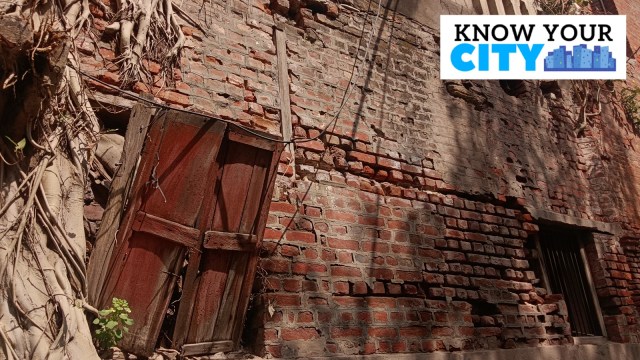Know Your City: How AMC plans to restore Ahmedabad’s 500-year-old fort wall by preserving its original features
The fort wall has become an integral part of those living in neighbourhoods like Shahpur, Khanpur, and Astodia of Ahmedabad.
 The inside of the fort wall. (Express Photo by Vishakha Toshniwal)
The inside of the fort wall. (Express Photo by Vishakha Toshniwal)Written by Vishakha Toshniwal
Inside the fort wall in the Astodia area of the old city, men are busy rolling out parathas and boiling tea as customers wait. Located near the historic Astodia Darwaja, this stall has been operating for 50 to 55 years and uses a section of Ahmedabad’s 500-plus-year-old fort wall as its backdrop.
The fort wall has become an integral part of the lives of those in the old city, especially in neighbourhoods like Shahpur, Khanpur, and Astodia. It stands between their homes and the bustling streets. The Ahmedabad Municipal Corporation (AMC) has undertaken the restoration of the fort wall, preserving most of its original features.
“My father moved to Ahmedabad 60 years ago and struggled with financial issues. Our neighbour suggested he put up the tea stall here as this place is lucky. And then everything eventually started to get going”, says the tea stall owner, preferring anonymity.
 A stall runs inside the fort wall. (Express Photo by Vishakha Toshniwal)
A stall runs inside the fort wall. (Express Photo by Vishakha Toshniwal)
Further down the wall, close to the newly built Atal Bridge on the Sabarmati River, a family that has lived here for five generations reminisces about how the ancient brick wall has become a part of their lives. A member of the family says, “This wall has been a part of our generations. My father, grandfather, I, and now my kids are living here. We are aware that Saint Manekbaba also lived here ages ago.”
He is referring to a legend about a hermit named Maneknath. Even the history of these walls has been passed down through generations, and legends say that Saint Manek lived here ages ago.
Maneknath, also known as Manekbaba, was a renowned saint from the 15th century. According to folklore, he frequently interrupted the construction of the fort wall. During the day, he would weave a mat or blanket, and the fort would crumble when he unravelled his weavings. This story has been passed down through the years.
 A street inside the walled city area. (Express Photo by Vishakha Toshniwal)
A street inside the walled city area. (Express Photo by Vishakha Toshniwal)
Sultan Ahmed Shah, the founder of Ahmedabad, consulted with Sheikh Ahmed Ganj Baksh Khattu, a revered Sufi saint from Sarkhej, to choose the location for the fort. He established the city in 1411 on the banks of the Sabarmati River. Ahmed Shah constructed the Bhadra Fort, while his grandson Mahmud Begda later built the fort’s walls. In 2017, Ahmedabad was recognised as a UNESCO World Heritage City. The city will celebrate its 614th foundation day on February 26.
According to records maintained by the AMC, in 1486, Mahmud Begda, the grandson of Ahmed Shah, fortified the city with an outer wall that had a circumference of 10 km (6 miles). This wall featured twelve gates, 189 bastions, and over 6,000 battlements. The city was planned according to the ancient Indo-Aryan tradition of a royal capital, which included main roads, thoroughfares, and subsidiary roads.
 The fort wall has become an integral part of the lives of those in the old city, especially in neighbourhoods like Shahpur, Khanpur, and Astodia. (Express Photo by Bhupendra Rana)
The fort wall has become an integral part of the lives of those in the old city, especially in neighbourhoods like Shahpur, Khanpur, and Astodia. (Express Photo by Bhupendra Rana)
The walls were approximately 2 to 3 meters wide and decorated with intricate arches, balconies, latticework, and murals. They were constructed using soil-based mortar, which could withstand cannon fire.
A prominent conservation architect of the city says, “The fort’s boundaries were marked with four pious individuals, as ‘Ahmads,’ symbolising the city’s four cardinal points. This was not territorial demarcation but carried a deeper meaning that the new city was not meant to replace Hindu settlements but to be an inclusive space for different communities. In 1833, local citizens took responsibility for restoring the fort walls through a ‘town wall fund committee’, which was established.”
 The Ahmedabad Municipal Corporation (AMC) has undertaken the restoration of the fort wall, preserving most of its original features. (Express Photo by Bhupendra Rana)
The Ahmedabad Municipal Corporation (AMC) has undertaken the restoration of the fort wall, preserving most of its original features. (Express Photo by Bhupendra Rana)
Sources have confirmed that a significant portion of the wall has been restored in 15 segments across 10 to 12 phases, with a budget of approximately Rs 70 lakh. Experts have noted that the restoration goes beyond mere aesthetic repairs, using the same materials that were employed in the past to ensure authenticity. After the restoration is complete, the AMC will take measures to preserve these walls.
“This restoration of the walls will help future generations understand their city better. Responsible urban planning will honour the past while accommodating the future,” says the architect.
(Vishakha Toshniwal is an intern with The Indian Express in Ahmedabad)







